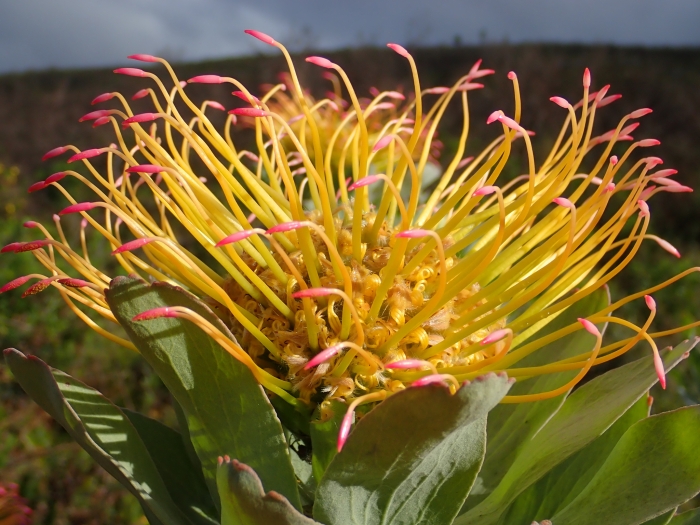Silver-Leaf Wheel-Pincushion
(Leucospermum formosum)
Silver-Leaf Wheel-Pincushion (Leucospermum formosum)
/
/

Nicola van Berkel
CC BY-SA 4.0
Image By:
Nicola van Berkel
Recorded By:
Copyright:
CC BY-SA 4.0
Copyright Notice:
Photo by: Nicola van Berkel | License Type: CC BY-SA 4.0 | License URL: http://creativecommons.org/licenses/by-sa/4.0/ | Rights Holder: Nicola van Berkel | Publisher: iNaturalist | Date Created: 2019-09-13T09:03:34-07:00 |


















Estimated Native Range
Summary
Leucospermum formosum, commonly known as the silver-leaf wheel-pincushion, is a large, evergreen shrub native to the fynbos region, specifically the southern slopes of the Riviersonderend, Langeberg, and Outeniqua Mountains in the Western Cape province of South Africa. It thrives in mountainous areas with cool, moist climates and is adapted to peaty soils found at elevations of 200-3,000 feet. This species typically grows up to 10 feet in height and is known for its striking appearance, with bright yellow, pincushion-like inflorescences that bloom from late winter to early spring (September and October in its native range). The lance-shaped, silvery leaves add to its ornamental value.
The silver-leaf wheel-pincushion is valued for its unique, showy flowers that attract a variety of pollinators, including Cape sugarbirds and sunbirds. In cultivation, it is used in ornamental gardens for its distinctive blooms and foliage. It requires well-drained, acidic soils and benefits from full sun exposure. While it is drought-tolerant once established, it does not tolerate frost well. Regular pruning after flowering can help maintain its shape and promote vigorous growth. Gardeners should be aware that this species is susceptible to root rot if overwatered or planted in poorly drained soils. It is also prone to fungal diseases and infestations by pests such as aphids. Due to its endangered status in the wild, cultivation in gardens can contribute to its conservation.CC BY-SA 4.0
The silver-leaf wheel-pincushion is valued for its unique, showy flowers that attract a variety of pollinators, including Cape sugarbirds and sunbirds. In cultivation, it is used in ornamental gardens for its distinctive blooms and foliage. It requires well-drained, acidic soils and benefits from full sun exposure. While it is drought-tolerant once established, it does not tolerate frost well. Regular pruning after flowering can help maintain its shape and promote vigorous growth. Gardeners should be aware that this species is susceptible to root rot if overwatered or planted in poorly drained soils. It is also prone to fungal diseases and infestations by pests such as aphids. Due to its endangered status in the wild, cultivation in gardens can contribute to its conservation.CC BY-SA 4.0
Plant Description
- Plant Type: Shrub
- Height: 3-5 feet
- Width: 5-8 feet
- Growth Rate: Moderate
- Flower Color: Yellow
- Flowering Season: Spring, Summer
- Leaf Retention: Evergreen
Growth Requirements
- Sun: Full Sun
- Water: Medium, High
- Drainage: Fast
Common Uses
Bird Garden, Border Plant, Drought Tolerant, Groundcover, Low Maintenance, Potted Plant, Rock Garden, Showy Flowers
Natural Habitat
Fynbos region, mountainous areas with cool, moist climates
Other Names
Common Names: Stink-leaf Nodding Pincushion, Giant Nodding Pincushion
Scientific Names: , Leucospermum formosum, Erodendrum formosum, Leucadendron formosum, Leucospermum formosum, Leucospermum formosum, Leucospermum medium, Protea coronata, Protea formosa, Protea formosa
GBIF Accepted Name: